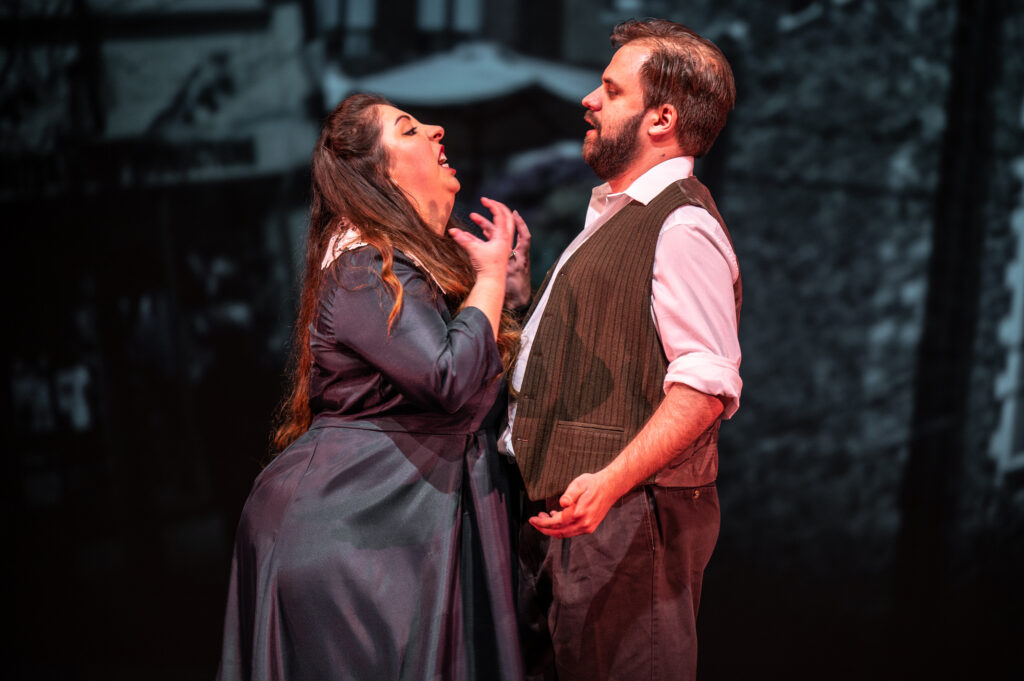The overture plays, violin and piano, tender and unadorned. The chorus enters, silent, reverential. A poignant montage of black and white images rises up to greet them at the rear of the stage, materializing and dissolving in the darkness, a lovingly assembled panorama of ancestral snapshots — the daring and the desperate, the irrepressible and the anxious, the eternally young and the hopeful setting sail from Castellammare, from Napoli and Palermo for a new life in a new world.
On a perfect, soft summer-like spring evening late last week, comfortably installed in Fleck Dance Theatre on Queen’s Quay, Toronto City Opera concluded its 2021/22 season with a fleeting 3-performance production of Cavalleria Rusticana to considerable dramatic effect. Boundlessly enthusiastic, abundantly inclusive, director Stephen Carr’s plainspun theatrical attitude to the piece brought a depth of authenticity to a verifiably folky rendition of Pietro Mascagni’s exquisite one-act verismo classic.
During the prosperous North American postwar boom period from 1951 – 1961, over 300,000 Italian immigrants, the vast majority from the southern regions of the peninsula, arrived in Canada, countless numbers finding solace and support in the growing community clustered along College Street east and west of Bathurst. Set in Toronto’s first Little Italy, this Cavalleria Rusticana took its cues, less from a sense of strict geography however, more from the abiding resonance of Carr’s opening scene. The act of recollection so vibrantly released in that moment was to provide something of an enduring reference point for City Opera’s often touching iteration, an emotional GPS of sorts, projected backdrops courtesy visual designer Cameron Davis only occasionally referencing specific scenic locales. A sign on a neighbourhood fruit and flower store. A towering close-up of the local Toronto Italian community’s landmark spiritual centre, St. Francis of Assisi, as strikingly familiar as it was resonant. Religion is every bit as much a dramatic catalyst as character in Cavalleria‘s highly volatile chemistry — one part devoutness, one part marital infidelity, one part rampant masculine pride — thoroughly infusing the excruciatingly intense linear action.
Adapted by librettist Giovanni Targioni-Tozetti from a story — ultimately a play — by late 19th century literary trailblazer Giovanni Verga, Mascagni’s breathlessly animated tale of passion and violence quickly seizes the imagination. A young man, Turiddu, returns from military service to find his lover, Lola, has wed the raffish Alfio in his absence. Wounded and disconsolate, Turiddu finds comfort in the arms of another, the ever-steadfast Santuzza, whom he abandons for an adulterous affair with his irresistibly beguiling former inamorata. The treacherous love triangle — Lola, Turiddu, Santuzza — makes for explosive outcomes. Heartbreak. Jealousy. Revenge. Alfio slays his rival as the entire community gathers in church to celebrate Easter Sunday.
Verismo, the depiction of everyday characters overcome by moments of supreme high drama, is by no means a manifestly self-evident genre. In the case of opera, the relatively few works that have come to define it have long been open to debate. Puccini’s Tosca traditionally qualifies for inclusion. Likewise Madama Butterfly despite its pronounced air of overarching exoticism. But not Turandot. Virtually anything by Umberto Giordano passes musicological muster. But not so the complete works of Francesco Cilea.
The stamp of academic legitimacy often tends to be more a matter of critical attitude and/or perceived shared musical values. Exuberant declamation; lush, cascading harmonies; distressed duets; gentle, languid intermezzi — all factor into a typically electrifying mix of compositional style and performance that is anything but commonplace or demonstrably naturalistic. In verismo opera, the sensational shares space, vocally and narratively, with the instantly identifiable. Music speaks of lives lived in real time. Story rushes forward.
When all has been said and sung, at slightly less than 90-minutes in length, Cavalleria Rusticana is an operatic masterpiece of singularly outsized proportions.
Appearing as City Opera’s heedless Turiddu, tenor Corey Arnold sang with an abundance of expansiveness in a role laden with virtuosic opportunity, launching the proceedings with a fine, soaring rendition of the deservedly celebrated siciliana, O Lola c’hai di latti la cammisa si bianca e russa comu la cirasa (“O Lola! Pure and ripe as the cherry in your nightdress white as milk”). Sung, not from the wings as is customary, but instead spotlit at centre stage, Arnold thrilled, charismatic and commanding from lights up to fade out.
In a powerful performance ringing with emotion, gifted singer-actor Angela Maria Sanchez offered us a Santuzza of remarkable scope, bringing great dignity and inner strength to the role, a limitless wellspring of resolve. Abused, rejected, condemned, this Santuzza fought back, proud and implacable, her rich, dynamic soprano ablaze with a fiercely expressed determination to survive. Marshalling her character’s rage, Sanchez positively blistered with fury in Mascagni’s fiery Turiddu/Santuzza duet. Tu qui, Santuzza? (“You here, Santuzza?”) A strong, unfailingly emphatic performance.
Singing Alfio, honey-toned baritone Andrey Andreychik presented us with a distinctly slippery, dangerously deceitful antagonist, handsome, popular, bubbling with charm. And quick with a knife. Mezzo-soprano Rachel Miller delighted as an incorrigibly coquettish Lola, stylish, coy, infinitely self-assured. Fellow mezzo, Lillian Brooks, was a busy, bustling Mamma Lucia, purveyor of heady wines and keeper of secrets.
Partnering on piano, artistic director Ivan Jovanovic, extracted a more than generous amount of colour from Mascagni’s bountiful score, violinist Oleksandra Fedyshyn occasionally joining him deep downstage left for added lyricism. The lush cascade of melody that is Cavalleria’s glorious Intermezzo proved particularly satisfying.
Music director Jennifer Tung conducted with great discretion and clarity.
A minimalist production, certainly. But glowingly veristic. A Cavalleria of genuinely human proportions.


